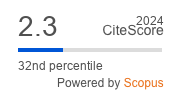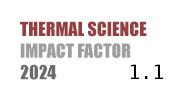THERMAL SCIENCE
International Scientific Journal
HYBRID VEHICLE BATTERY FIRES EXPERIMENTAL INSIGHTS AND RISK EVALUTION
ABSTRACT
This study investigates the fire behavior of lithium-ion batteries used in hybrid electric vehicles under gasoline-induced thermal conditions. In the experimental set-up, 2 L of gasoline were ignited to analyze and compare the thermal responses of a 6 cell 18650 cylindrical battery pack and a prismatic battery. Temperature changes were recorded at T1 and T2 points using K-type thermocouples, and the thermal reactions of each battery type were evaluated. Both batteries exhibited safety valve activation, thermal runaway, and jet flame emissions. The prismatic battery initially showed higher resistance, yet eventually underwent a similar failure sequence. Maximum temperatures reached 981.3°C at T2 and 765.4°C at T1, indicating the severity of the thermal runaway process. The findings demonstrate that hydrocarbon fuel significantly intensifies battery reactions and highlight the necessity of improved fire safety strategies in hybrid systems. This study provides a valuable foundation for future research on battery safety and fire risk mitigation in multi-energy vehicle configurations.
KEYWORDS
PAPER SUBMITTED: 2025-04-08
PAPER REVISED: 2025-06-18
PAPER ACCEPTED: 2025-07-10
PUBLISHED ONLINE: 2025-09-26
THERMAL SCIENCE YEAR
2025, VOLUME
29, ISSUE
Issue 4, PAGES [3105 - 3111]
- Feng, X., et al., Thermal Runaway Mechanism of Lithium Ion Battery for Electric Vehicles: A Review, Energy Storage Mater, 10 (2018), Jan., pp. 246-267
- Kumar, K., Flammability of Plastics in Today's Automobiles, SAE Technical Papers, 2015-01-1380, 2015
- Sun, P., et al., A Review of Battery Fires in Electric Vehicles, Fire Technol., 56 (2020), Jan., pp. 1361-1410
- Wang, Q., et al., A Review of Lithium Ion Battery Failure Mechanisms and Fire Prevention Strategies, Prog Energy Combust Sci, 73 (2019), July, pp. 95-131
- Balakrishnan, P. G., et al., Safety Mechanisms in Lithium-Ion Batteries, J. Power Sources, 155 (2006), 2, pp. 401-414
- Tobishima, S. I., Yamaki, J. I., A Consideration of Lithium Cell Safety, J. Power Sources, 81-82 (1999), Sept., pp. 882-886
- Evarts, E. C., Lithium Batteries: To the Limits of Lithium, Nature, 526 (2015), Oct., pp. 93-95
- Lecocq, A., et al., Scenario-Based Prediction of Li-Ion Batteries Fire-Induced Toxicity, J. Power Sources, 316 (2016), June, pp. 197-206
- Warns, S., Some New Laptop Batteries May Catch Fire - The New York Times, (n. d.). www. nytimes.com/2014/04/12/technology/sony-warns-some-new-laptop-batteries-may-catch-fire.html, 2025
- Van Batenburg, C., Introduction HEV, PHEV, and EV: For Technicians and Students New to High-Voltage Systems, Automotive Career Development Center, 2014, books.google.com.hk/books?id=esiyoQEACAAJ, 2025
- ***, Gas vs. Electric Car Fires: Understanding the Safety Factors, (n. d.). www.agilerates.com/ advice/auto/gas-vs-electric-car-fires, 2025
- ***, Home | StrategicRISK Global, (n.d.). www.strategic-risk-global.com,2025
- ***, The Fire Safety Research Institute (FSRI), part of UL Research Institutes, (n. d.). fsri.org, (2025
- Zalosh, R., Gandhi, A., Barowy, Lithium-Ion Energy Storage Battery Explosion Incidents, J. Loss Prev. Process Ind., 72 (2021), 104560
- Tarascon, J. M., Armand, M., Issues and Challenges Facing Rechargeable Lithium Batteries, Nature, 414 (2001), Nov., pp. 359-367
- Mao, Y., et al., Review of Flame Behavior and Its Suppression during Thermal Runaway in Lithium-Ion Batteries, Batteries, 10 (2024), 307
- Deng, Y., et al., Effects of Different Coolants and Cooling Strategies on the Cooling Performance of the Power Lithium Ion Battery System: A Review, Appl. Therm. Eng., 142 (2018), Sept., pp. 10-29
- Larsson, F., Mellander, B. E., Lithium-Ion Batteries used in Electrified Vehicles - General Risk Assessment and Construction Guidelines from a Fire and Gas Release Perspective, 2017, urn.kb.se/resolve?urn=urn:nbn:se:ri:diva-31320, 2025
- Doughty, D., Roth, E. P., A General Discussion of Li Ion Battery Safety, Electrochemical Society Interface, 21 (2012), 2, pp. 37-44
- C. Un, et al., Experimental Study of Fire Suppression for Li-Ion Electric Batteries WITH H2O, Fresenius Environ Bull 30, 2021, avesis.cu.edu.tr/yayin/1eed4689-f18a-490e-b3d5-ec0cd5cc478f/experimental-study-of-fire-suppression-for-li-ion-electric-batteries-with-h2o, 2025
- Meng, X., et al., Experimental Study of Intermittent Spray Cooling on Suppression for Lithium Iron Phosphate Battery Fires, ETransportation, 11 (2022), 100142
- Huang, Q., et al., Innovative Thermal Management and Thermal Runaway Suppression for Battery Module with Flame Retardant Flexible Composite Phase Change Material, J. Clean Prod., 330 (2022), 129718
- Zhou, W., et al., Inhibition Effect of Inert Gas Jet on Gas and Hybrid Explosions Caused by Thermal Runaway of Lithium-Ion Battery, J. Loss Prev. Process Ind., 90 (2024), 105336

